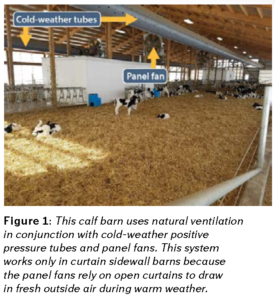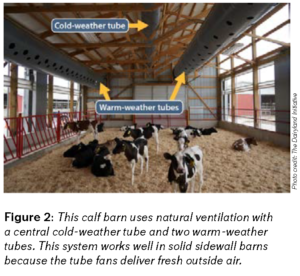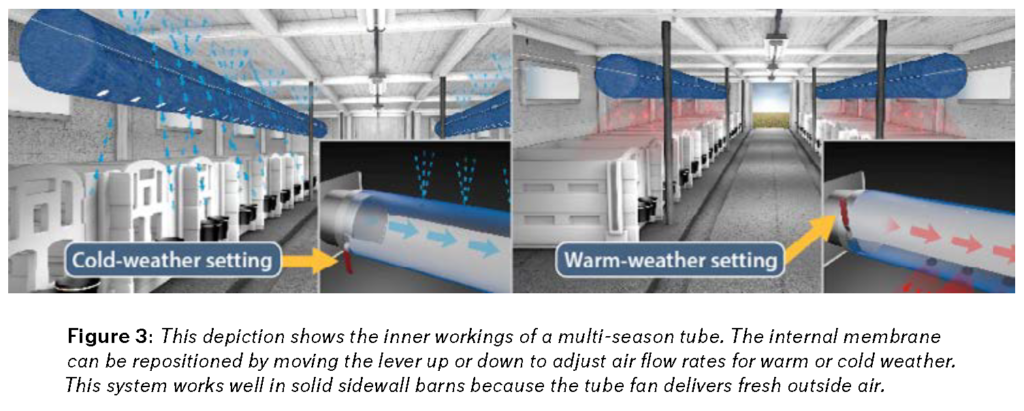Keep Calves Off The Temperature Roller Coaster
Click here to view as a pdf: Keep Calves Off The Temperature Roller Coaster
Spring and fall weather conditions often present calf raisers with the challenge of fluctuating temperatures. The rapid and ongoing transition from warm days to cold nights creates a temperature roller coaster that can increase calfhood respiratory disease rates.
The ventilation rates applied to calf barns are based on outside weather conditions, namely the ambient air temperature. During warmer weather, calf barns are ventilated with an increased volume and speed of fresh air. Conversely, during cold weather, calf barns are ventilated with lower volumes and slower fresh air speeds to prevent a draft.
Ventilation systems that cannot be adjusted in response to changing outside temperatures will leave calves over or under ventilated. To best cope with the ever-changing spring and fall weather conditions, calf barn managers must be able to quickly and easily adjust their ventilation systems to increase or decrease the volume and speed of fresh air throughout the day.
Calf raisers use different ventilation systems with varying degrees of success. However, a good ventilation system must:
- Provide the correct volume of fresh air based on seasonal requirements by increasing volume during warm weather and decreasing volume during cold weather.
- Evenly distribute fresh air to the calf.
- Deliver fresh air to the calf at the correct speed based on the season; faster speeds (200-400 feet per minute) for warm weather heat abatement; slow, non-drafty speeds (less than 50 feet per minute) during cold weather.
- Provide for easy adjustment of fresh air volume and speed in response to the warm days and cold nights of spring and fall.
Below are three types of calf barn ventilation systems that are able to meet these criteria.
- Cold weather positive-pressure tubes with panel fans
This tube system contains numerous small holes (typically .75-to 1.5-inch diameter) that release a slow, gentle blanket of fresh air for cold weather ventilation (Figure 1). Although the tubes are designed for cold weather use and only minimally contribute to warm weather ventilation, it is important to run this system in the summer when the curtain sidewalls are open because an inflated tube remains taut and less prone to wind damage.
 During spring and fall, curtain sidewalls are progressively opened from the bottom as the weather warms. Variable speed basket or panel fans can be turned on low to slowly increase air speed as needed. For heat abatement during warm weather, curtains are opened completely, and the basket or panel fans operate on high to circulate the incoming fresh air at high speeds.
During spring and fall, curtain sidewalls are progressively opened from the bottom as the weather warms. Variable speed basket or panel fans can be turned on low to slowly increase air speed as needed. For heat abatement during warm weather, curtains are opened completely, and the basket or panel fans operate on high to circulate the incoming fresh air at high speeds.
Variable-speed basket or panel fans can quickly and easily be manipulated in conjunction with the curtain sidewalls to adjust both the volume and speed of fresh air delivered to the calf. Thermostatic controllers and total weather stations can completely automate the process.
This type of system is best suited to the open pen layouts of automatic calf feeders or post-weaned pens. It is not advisable to use this type of system in calf barns with solid-sided individual pens. Basket or panel fans direct air downward at roughly a 30-degree angle. When air blows across a row of individual pens with solid sides, the sidewalls deflect air and prevent it from reaching the calf.
- Warm weather and cold weather positive-pressure tubes
This system combines multiple positive-pressure tubes, each designed for different seasonal applications (Figure 2). While commonly used in combination with curtain sidewalls, this system is not dependent on them because the tubes bring in fresh outside air. Consequently, it can be used in solid wall buildings as well. 
These systems typically have multiple warm weather tubes with large-diameter holes for fast, high volume airflow and a single cold weather tube containing numerous small-diameter holes for slow, gentle air distribution. The tubes can direct fresh air straight down into a row of individual pens without the pen’s solid sides blocking air flow.
Warm weather tube fans are most commonly single speed and are turned on/off as needed. Closing curtains when the warm weather fans are off will prevent wind damage to the deflated tubes. These fans can be automated to turn on/off with a thermostatic controller, making them effective tools to handle the warm days and cold nights of spring and fall.
- Multi-season positive-pressure tubes
Multi-season tubes combine warm weather and cold weather positive-pressure tubes into one unit. Each tube contains an internal membrane that runs the length of it. This membrane is used to block, restrict or change direction of air exiting the tube, achieving the desired airflow based on seasonal requirements. These systems are connected to variable speed fans and have an array of numerous small holes on one side of the tube and fewer, larger holes on the opposite side. When the fan is turned on, air pressure pushes the internal membrane against an inside wall of the tube. The membrane blocks one of the hole patterns while exposing the other. This allows air to be discharged out the small hole pattern for cold weather or the large hole pattern for warm weather (Figure 3).
Like the cold and warm season tubes, multi-season tubes can also be used to rapidly and easily adjust fresh air volume and speed to match the warm days and cold nights of spring and fall.
The multi-season tube is placed over the calf pen area and during warm weather the larger hole pattern is pointed down towards the calves. The variable speed tube fan is turned on high, increasing the volume of air delivered. The large holes release robust jets of air, delivering fast, cooling air to the calf.
When the weather cools, a lever mechanism connected to the fan can be used to adjust the internal membrane to the bottom of the tube, blocking the large diameter holes and redirecting the air out of the small holes in the top of the tube, away from the calves. At the same time, the variable speed fan is turned on low, reducing the output. This style of multi-season tube is particularly useful for retrofitted stanchion barns because the air discharged out the top of the tube bounces off the low ceiling and gently falls into the calf pen.
In the winter, producers who have barns with taller sidewalls will commonly use a rotating mechanism to adjust the tube so the small holes are open, facing down towards the calves to discharge a gentle blanket of fresh air.
Multi-season tubes are being used successfully in every type of calf barn style and pen layout and eliminate the additional expense of warm weather fans.
What is right for your farm?
Having a proper ventilation system that keeps your calves comfortable and off the spring and fall temperature roller coaster is essential to raising healthy calves. Consult a ventilation professional to help you determine which system will work best for your operation’s ventilation needs.


